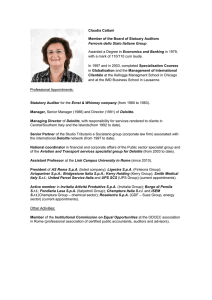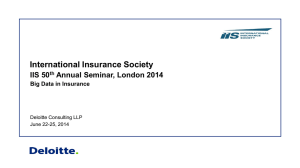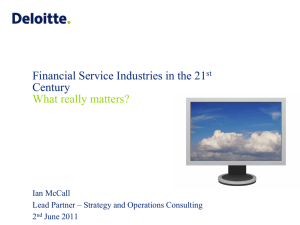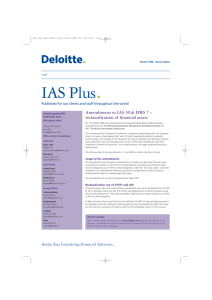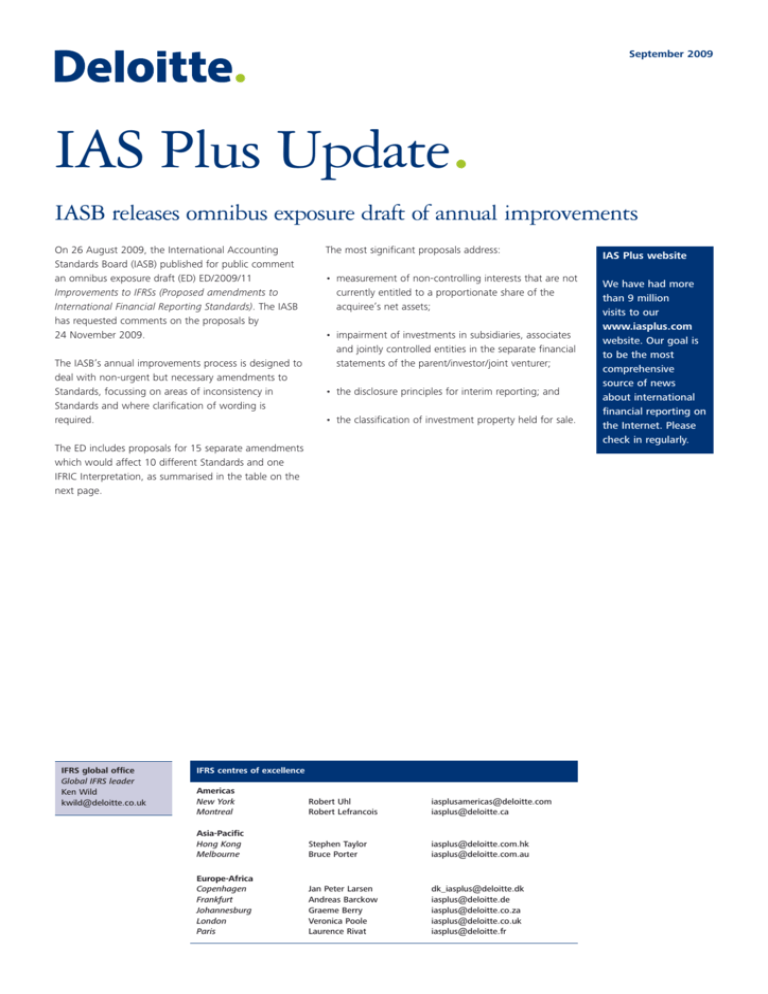
September 2009
IAS Plus Update.
IASB releases omnibus exposure draft of annual improvements
On 26 August 2009, the International Accounting
Standards Board (IASB) published for public comment
an omnibus exposure draft (ED) ED/2009/11
Improvements to IFRSs (Proposed amendments to
International Financial Reporting Standards). The IASB
has requested comments on the proposals by
24 November 2009.
The IASB’s annual improvements process is designed to
deal with non-urgent but necessary amendments to
Standards, focussing on areas of inconsistency in
Standards and where clarification of wording is
required.
The most significant proposals address:
• measurement of non-controlling interests that are not
currently entitled to a proportionate share of the
acquiree’s net assets;
• impairment of investments in subsidiaries, associates
and jointly controlled entities in the separate financial
statements of the parent/investor/joint venturer;
• the disclosure principles for interim reporting; and
• the classification of investment property held for sale.
The ED includes proposals for 15 separate amendments
which would affect 10 different Standards and one
IFRIC Interpretation, as summarised in the table on the
next page.
IFRS global office
Global IFRS leader
Ken Wild
kwild@deloitte.co.uk
IFRS centres of excellence
Americas
New York
Montreal
Robert Uhl
Robert Lefrancois
iasplusamericas@deloitte.com
iasplus@deloitte.ca
Asia-Pacific
Hong Kong
Melbourne
Stephen Taylor
Bruce Porter
iasplus@deloitte.com.hk
iasplus@deloitte.com.au
Europe-Africa
Copenhagen
Frankfurt
Johannesburg
London
Paris
Jan Peter Larsen
Andreas Barckow
Graeme Berry
Veronica Poole
Laurence Rivat
dk_iasplus@deloitte.dk
iasplus@deloitte.de
iasplus@deloitte.co.za
iasplus@deloitte.co.uk
iasplus@deloitte.fr
IAS Plus website
We have had more
than 9 million
visits to our
www.iasplus.com
website. Our goal is
to be the most
comprehensive
source of news
about international
financial reporting on
the Internet. Please
check in regularly.
Detail of proposed amendments
The following table provides a summary of each of the amendments proposed in the ED.
Standard
Topic
Proposed amendment
IFRS 1
First-time Adoption of
International Financial
Reporting Standards
Accounting policy changes in the year of
adoption
Clarifies that, if a first-time adopter changes its accounting policies or its use of the
exemptions in IFRS 1 after it has published an interim financial report in accordance
with IAS 34 Interim Financial Reporting, it should explain those changes and update
the reconciliations between previous GAAP and IFRSs.
Proposed effective date: 1 January 2011.
Revaluation basis as deemed cost
Clarifies that first-time adopters are permitted to use a revaluation basis as ‘deemed
cost’ for revaluations that occurred after the date of transition to IFRSs but during the
period covered by the first IFRS financial statements.
Proposed effective date: 1 January 2011.
IFRS 3
Business Combinations
(2008)
Measurement of non-controlling interests Clarifies that the option to measure non-controlling interests either at fair value or at
the non-controlling interest’s proportionate share of the acquiree’s identifiable net
assets under IFRS 3(2008) applies only to instruments that are currently entitled to a
proportionate share of the acquiree’s net assets. Other instruments that meet the
definition of non-controlling interests should be measured at fair value or in accordance
with applicable IFRSs.
Proposed effective date: 1 July 2010.
Un-replaced and voluntary replaced
share-based payment awards
Introduces specific guidance clarifying that share-based payment awards of the
acquiree that the acquirer chooses to replace (although not part of the business
combination arrangements) or for which vesting is accelerated as a consequence of the
business combination should be accounted for in the same way as awards that the
acquirer is obliged to replace as part of the business combination arrangements.
Proposed effective date: 1 July 2010.
Transitional requirements for contingent
consideration from a business
combination that occurred before the
effective date of IFRS 3(2008)
Clarifies that IAS 32 Financial Instruments: Presentation,
IAS 39 Financial Instruments: Recognition and Measurement and IFRS 7 Financial
Instruments: Disclosures do not apply to contingent consideration that arose from
business combinations whose acquisition dates preceded the application of
IFRS 3(2008).
Proposed effective date: 1 July 2010.
IFRS 5
Non-current Assets Held for
Sale and Discontinued
Operations
Application of IFRS 5 to loss of significant Clarifies that an interest in an associate or a jointly controlled entity should be classified
influence over an associate or loss of
as held for sale under IFRS 5 when an entity is committed to a sale plan involving a loss
joint control in a jointly controlled entity of significant influence or joint control.
IFRS 7
Financial Instruments:
Disclosures
Disclosures about the nature and extent
of risks arising from financial instruments
Clarifies the required level of disclosure for financial instruments.
IAS 1
Presentation of Financial
Statements
Clarification of statement of changes in
equity
States explicitly that an entity may present the components of changes in equity either
in the statement of changes in equity or in the notes to the financial statements.
IAS 8
Accounting Policies,
Changes in Accounting
Estimates and Errors
Change in terminology to the qualitative
characteristics
IAS 27
Consolidated and Separate
Financial Statements (2008)
Impairment of investments in subsidiaries,
jointly controlled entities and associates in
the separate financial statements of the
investor
Proposed effective date: 1 January 2010.
Proposed effective date: 1 January 2011.
Proposed effective date: 1 January 2011.
Aligns terminology with the changes made in the forthcoming chapter on qualitative
characteristics of the conceptual framework that will replace the equivalent section in
the Framework for the Preparation and Presentation of Financial Statements.
Proposed effective date: 1 January 2011.
Clarifies that in its separate financial statements the parent/investor/ joint venturer
should apply the requirements of IAS 39 Financial Instruments: Recognition and
Measurement (and not IAS 36 Impairment of Assets) to test its investments in
subsidiaries, jointly controlled entities and associates for impairment, regardless of
whether they are carried at cost or in accordance with IAS 39.
Proposed effective date: 1 January 2011 (prospective application).
Transitional requirements for
consequential amendments as a result of
the 2008 revision of IAS 27
Clarifies that the amendments made to IAS 21 The Effects of Changes in Foreign Rates,
IAS 28 Investments in Associates and IAS 31 Interests in Joint Ventures as a result of
IAS 27(2008) should be applied prospectively (with the exception of paragraph 35 of
IAS 28 and paragraph 46 of IAS 31, which should be applied retrospectively).
Proposed effective date: 1 July 2010.
IAS 28
Investments in Associates
Partial use of fair value for measurement
of associates
Clarifies that different measurement bases can be applied in consolidated financial
statements to portions of an investment in an associate when part of the investment is
designated at initial recognition as at fair value through profit or loss in accordance
with the scope exception in paragraph 1 of IAS 28.
Proposed effective date: 1 January 2011.
Standard
Topic
Proposed amendment
IAS 34
Interim Financial Reporting
Significant events and transactions
Emphasises the disclosure principles in IAS 34 and adds further guidance regarding how
to apply these principles, particularly in respect of financial instruments and their fair
values.
Proposed effective date: 1 January 2011.
IAS 40
Investment Property
Change from fair value model to cost
model
Removes the requirement to transfer investment property to inventories when it will be
developed for sale and brings investment property meeting IFRS 5’s held-for-sale
criteria within the scope of that Standard.
Proposed effective date: 1 January 2011 (prospective application).
IFRIC 13
Customer Loyalty
Programmes
Determination of fair value
Clarifies the meaning of the term ‘fair value’ by illustrating that when the fair value of
award credits is measured based on the value of the awards for which they could be
redeemed, the value of the awards for which they could be redeemed must be adjusted
to reflect expected forfeitures.
Proposed effective date: 1 January 2011.
For more information on Deloitte Touche Tohmatsu, please access our website at www.deloitte.com
Deloitte provides audit, tax, consulting, and financial advisory services to public and private clients spanning multiple industries.
With a globally connected network of member firms in 140 countries, Deloitte brings world-class capabilities and deep local expertise
to help clients succeed wherever they operate. Deloitte’s 150,000 professionals are committed to becoming the standard of excellence.
Deloitte’s professionals are unified by a collaborative culture that fosters integrity, outstanding value to markets and clients,
commitment to each other, and strength from cultural diversity. They enjoy an environment of continuous learning, challenging
experiences, and enriching career opportunities. Deloitte’s professionals are dedicated to strengthening corporate responsibility,
building public trust, and making a positive impact in their communities.
Deloitte refers to one or more of Deloitte Touche Tohmatsu, a Swiss Verein, and its network of member firms, each of which is
a legally separate and independent entity. Please see www.deloitte.com/about for a detailed description of the legal structure of
Deloitte Touche Tohmatsu and its member firms.
This publication contains general information only and is not intended to be comprehensive nor to provide specific accounting,
business, financial, investment, legal, tax or other professional advice or services. This publication is not a substitute for such
professional advice or services, and it should not be acted on or relied upon or used as a basis for any decision or action that may
affect you or your business. Before making any decision or taking any action that may affect you or your business, you should
consult a qualified professional advisor.
Whilst every effort has been made to ensure the accuracy of the information contained in this publication, this cannot be guaranteed,
and neither Deloitte Touche Tohmatsu nor any related entity shall have any liability to any person or entity that relies on the
information contained in this publication. Any such reliance is solely at the user’s risk.
© Deloitte Touche Tohmatsu 2009. All rights reserved.
Designed and produced by The Creative Studio at Deloitte, London. 32501


